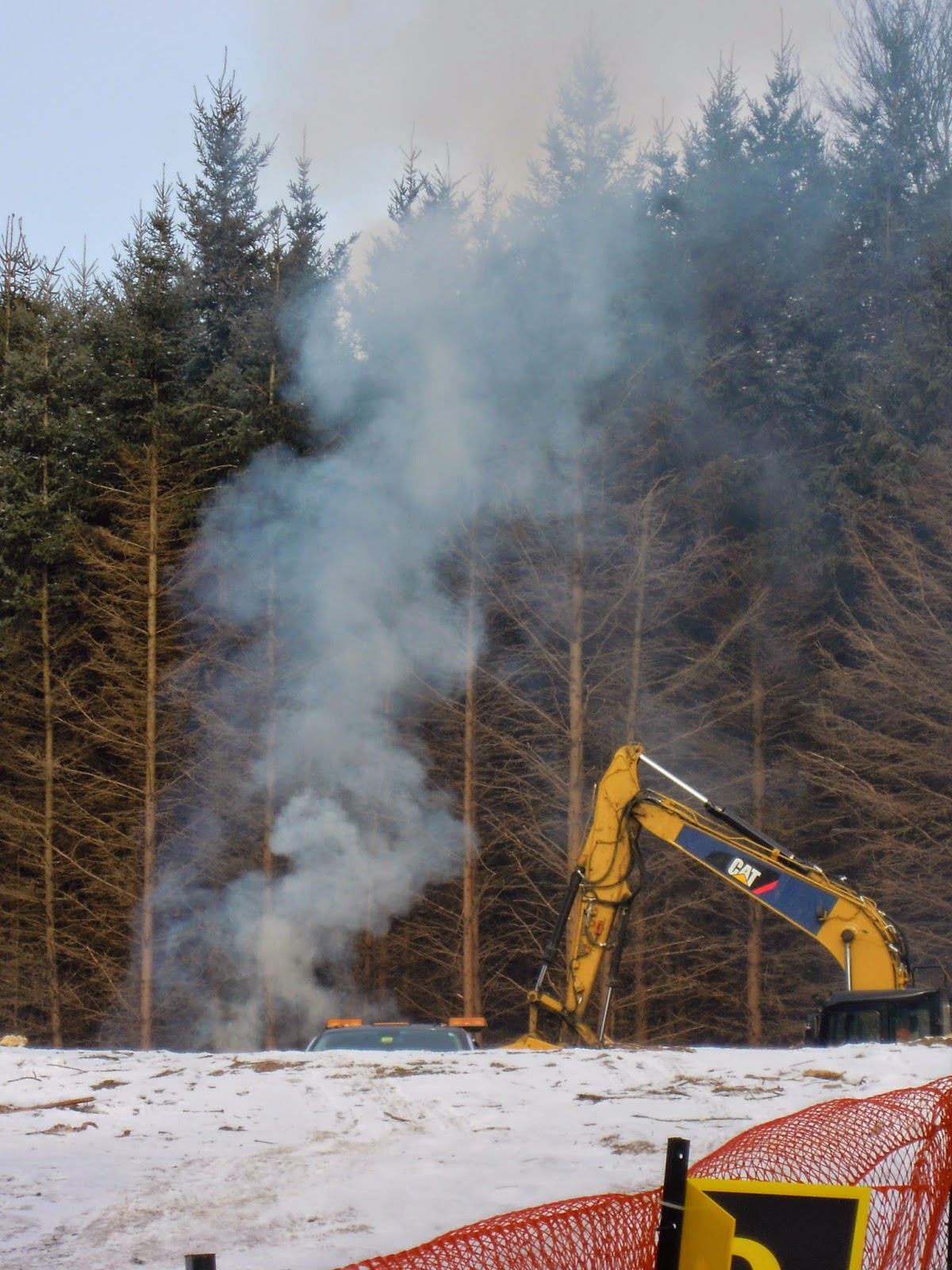A Photo Gallery Illustrating the Reality of This Situation
To highlight the contrast between
the policies and reality, excerpts from
the NEC concerning conservation and wildlife preservation are included,
following the photos.
Welcome
to what might be called The NEC Policies
Versus Reality page.
A great deal of damage has been done
to the natural environment as a result of what we see as the negligence of the
agencies involved Now, when we look out the windows of our home,
instead of once-beautiful views and a wildlife system that worked splendidly,
we see betrayal on all sides. This
situation is absolutely unacceptable, and must be remedied before any more
serious damage occurs. There’s a cynical
game being played over here, just out of sight of the road. It is putting animal and human safety at
risk, and it will only get worse until someone with authority puts a stop to
this flagrant misbehaviour.
Anyway, here’s reality. Here’s
what’s really been going on at 979
Governors Road, just up behind the trees:
See that pile of stuff behind the
swings? That’s one of the many mounds of
wood chips we saw created last winter. Those
chips had been 30’ conifers only hours before.
The trees themselves were each uprooted, not cut, and flung down heavily
on the frozen January ground. Using the
heavy-handed instruments of destruction we witnessed here, pulling up a huge
tree takes no more time than pulling a weed.
This is disturbing knowledge I wish I didn’t have. As we told the NEC planner we consulted with
back in 2013, we did not want a front row to destruction – and yet that is what
we have here, in spades. This tree
destruction went on for weeks; the contractors kept the wood chipper and
chainsaws busy throughout January 2015.
The garage to the left and children’s
swings are on our property. The swing on
the right was formerly my favourite outdoor place to work (I’m a writer). It was secluded, shady and incredibly
beautiful up there. This was one of the
few places you could sit quietly and watch the ongoing wildlife activity in the
old deer yard. I saw a wide variety of
animals up there every day. There were
fireflies every night in midsummer.
Though I usually wrote up here, I
also took photographs. Had I known the
deer yard was doomed, I would have taken many more – but, in those days, we
still believed what we had been told about the protection of wildlife habitats. Now, I’m very glad I took those photographs
when I did.
Without
the photographs, there would be absolutely no evidence that the deer yard ever
existed. That is why we feel it is
vitally important to share them online.
More eyes than ours need to witness what has happened here.
As if all the wood chipping wasn’t
enough – the contractors also burned
the uprooted trees, for weeks on
end, throughout January 2015. This photo
was taken on a low-smoke day. On
heavy-smoke days, I couldn’t bear to go outside in it. Some days, driving south down Weirs Lane
toward Governors Road, the smoke blown across it was so thick you could barely
see the road. The residents along lower
Weirs must have been choking, that terrible month.
One
cold January day, my hopes soared when I saw a fire engine pulled up at the
bottom of our driveway, and several firefighters came up to investigate the
forest fire. It seems a neighbour
had called to report a forest fire. Now,
perhaps, someone with some authority would finally tell these careless contractors
to cease and desist! Alas, no. What I saw from my dining room window was very
disturbing. The firefighters and
contractors appeared to be very chummy.
Only a few minutes after they arrived, after back-slapping and guffawing together at the top of the driveway,
the firefighters said goodbye to the contractors and walked back down the
driveway. The fire truck went away. The burning continued, just as before. During this time, we called the City of
Hamilton to inquire whether or not there had been a Burn Permit issued. The City refused to tell us.
Apologies for the blurriness here –
my hands shake when I’m upset, and taking these photographs was incredibly
upsetting. This is one of far too many
piles of dead trees we witnessed throughout the winter.
Remains of protected trees
This bleak and barren landscape once
contained trees designated “protected” by the Niagara Escarpment Commission and
were clearly shown as such on their tree map.
To our distress, we were the only
people involved who ever seemed to refer to the tree map. Early on, the property owner said to
clear it all out. Regardless of any
rules or guidelines, that’s just what the contractors did.
Here are some “Before” photos, to
show you how inviting the wildlife corridor was (and still is) to animals. To highlight the contrast between the
policies and reality, excerpts from the
NEC concerning conservation and wildlife preservation are noted below. This is well worth a visit. See for yourself how these lofty words
measure up to the pictorial evidence of what’s been going on.
Wildlife corridor looking north - Aug 2014
This primary wildlife corridor on
our property offers wildlife access to our back yard, just up to the left at
this point. It also used to offer access
to the the deer yard, up at the top.
About one-fourth of the deer (the bolder ones) came up into our yard,
before going on up the hill through the deer yard’s backyard entrance. That old backyard entrance is now fenced off, and the deer yard is gone.
Wildlife corridor secondary path
This secondary wildlife corridor
lies just to the right of the one above.
When winter snowfalls tell their
tales at the southern end of these two corridors, as they do in the photo
below, they clearly show both “lanes” are extremely busy, with a variety of
animal tracks.
However, larger animals can now only
turn around when they reach the barriers at the top, then eventually head back
down across Governors Road. This creates
an unsafe situation for both deer and humans.
This was the top of our wildlife
corridor in September, 2014 – the good old days, before any destruction or
fencing took place. This is a very busy
route in every season – and is it any wonder?
Can you imagine a more inviting path for wildlife than this? About three-fourths of the deer took this
route, going straight on up to shelter in the deer yard (which used to be just
above here and to the left, where the hill in the photo rises). The pond they all drank from lies straight
ahead, in the thick forest.
This route is now fenced off and
impassable. The deer yard has been
destroyed. The pond, though still up there,
is now inaccessible to many of the wildlife who depended on it. Deer approaching from the south now turn back
and drink from the ditch along Governors Road.
See the conifer to the right of the bare
deciduous tree? That’s one of ours, and
it’s in a bad way since all that destruction last January. Until the far-too-close, relentless bashing
and smashing on the frozen ground, this tree stood as straight as an arrow and
was very healthy. Now it is dying from
the top, as they do when their shallow roots are disturbed, and beginning to
droop down onto its neighbour. If/when
we lose this tree, we also lose what very little privacy is still left in our
back yard. Another tree, in our deer
corridor, has fallen over completely.
All
of this damage could have been avoided, had the development respected the
“Development Zone” clearly shown on the approved plans.
Here are a few shots of the aftermath.
Top of deer corridor – winter tracks
All the deer that came up this
corridor last winter, looking for the old reliable shelter and water they have
used for generations, were stopped short by the fencing.
Tracks – deer stopped at fence
The tracks and deer poop here
clearly show where deer are now stopped at the fence. This is where the old entrance to the deer
yard from our back yard was.
(The one and only good thing about
the damage and destruction done during the deep freeze of winter was that snow
was so often on the ground. When it
comes to showing where deer go, snow is our friend!)
The
3 agencies involved have all refused to address this situation in a timely
manner.
They
did not do their jobs. Why on earth are
our taxes paying the employees of these agencies?
It appears that only the interests of the property owners and their contractor are being
protected – certainly not wildlife
or the natural environment.
Why
is this blatantly bad behaviour being rewarded?
What follows are the Niagara Escarpment Commission
(NEC) policies and development permit conditions regarding tree and wildlife
preservation regarding construction at 959 Governors Road. Pertinent
excerpts include:
NEC Policies:
Section 2.7 - New
Development Within Wooded Areas
The objective is to
ensure that the new development should preserve as much as possible of wooded
areas
1. Disturbance
of treed areas should be minimized, and proposed developments in heavily treed
areas shall have site plan agreements containing specific management details
regarding the protection of existing trees.
2. Trees
to be retained should be protected by means of snow fencing, wrapping, or other
acceptable means during construction (e.g. tree wells).
Section 2.8 –
Wildlife Habitat
The objective is to
minimize the impact of new development on wildlife habitat
2. Development shall
be designed so as to:
b) Maintain wildlife corridors and linkages
within adjacent areas; and
c) Enhance wildlife habitat wherever possibleSection 2.9 – Forest Management
The objective is to
maintain and enhance the forests and associated animal and plant habitats.
2. Approval to cut
is conditional upon:
b) Minimizing
disruption of habitats for plants and animal species occurring in the
area.
c) Retaining the diversity of tree species.
d) Aiming over the long term to retain or enhance the quality, appearance
and productivity of the forest site.
5. Any tree cutting program should include natural regeneration or rehabilitation through reforestation where necessary.
(Again, these are direct quotes from the ruling.)
1. Non-fulfillment or
breach of any one of the conditions shall render the Development Permit void.
5. Development shall
take place only in accordance with the site plan and development permit
application submitted.
7. No trees other
than dead or diseased trees shall be cut or removed from the lot in the area of
the development except those absolutely necessary for the construction of the
new dwelling.
9. …The applicants
are advised that a Tree Protection Plan
(TPP) prepared according to the City of Hamilton’s Tree Protection Guidelines
and a Landscape Plan will be
required for submission with the Site Plan Control application. The
TPP is to show how many trees will be preserved or removed for the development and
the Landscape Plan will show the compensation trees to be planted on site. Compensation is required on a 1:1 basis
Further notes stress that “the applicant’s swimming pool and/or deck be designed to prevent
wildlife (mammals, amphibians, reptiles) from entering the pool. The incorporation of appropriate wildlife
fencing around the pool is supported by the City of Hamilton Environmentally
Significant Areas Impact Evaluation Group (ESAIEG) and the Niagara Escarpment
Commission.”
Further, “the applicants are advised by ESAIEG of its
recommendation and support for the removal of debris and garbage from the most
easterly pond to facilitate its use by
local wildlife… The Niagara Escarpment Commission recommends that site
disturbance associated with any litter or garbage removal be minimal and any
disturbance be rehabilitated immediately following the activity.”













No comments:
Post a Comment